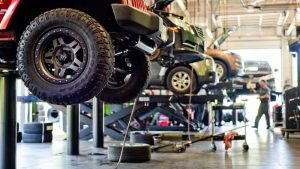When it comes to vehicle maintenance, most drivers focus on oil changes, tire pressure, and brakes — but the suspension system deserves equal attention, especially as the seasons change. The suspension components, including shocks, struts, control arms, and bushings, endure vastly different conditions between winter and summer. Understanding how temperature, road conditions, and environmental factors affect your suspension can help prevent wear, maintain safety, and extend component life.
This guide will explore the key differences in winter vs. summer suspension challenges, how to adapt your maintenance routine, and when to consider replacing worn parts.
Why Seasonal Suspension Care Matters

The suspension system ensures comfort, stability, and tire contact with the road. Yet, factors such as temperature fluctuations, salt exposure, and humidity can drastically alter how it performs.
Neglecting seasonal care leads to:
-
Premature wear of bushings, springs, and dampers
-
Corrosion of metal components
-
Reduced handling performance
-
Increased road noise and vibration
Proactive maintenance not only keeps your ride smooth but also preserves steering precision and braking effectiveness throughout the year.
How Winter Affects Your Suspension
Winter brings freezing temperatures, road salt, and potholes — a combination that can wreak havoc on your suspension components.
Common Winter Challenges:
| Winter Factor | Effect on Suspension | Preventive Action |
|---|---|---|
| Road Salt | Causes corrosion on springs, control arms, and mounts | Wash undercarriage frequently, apply anti-rust spray |
| Cold Temperatures | Reduces elasticity of rubber bushings and seals | Inspect for cracks or stiffness; replace worn rubber parts |
| Potholes | Damage shocks, struts, and ball joints due to impacts | Check alignment and inspect for leaks after harsh bumps |
| Ice Build-Up | Adds weight and stress to suspension components | Clean wheel wells and undercarriage regularly |
| Reduced Tire Grip | Forces suspension to work harder to maintain traction | Ensure tires and shocks are in good condition |
Key Winter Maintenance Tips:
-
Inspect Shock Absorbers: Leaking or weak shocks compromise stability on icy roads.
-
Lubricate Joints and Bushings: Prevents freezing and cracking.
-
Clean Undercarriage: Removes salt and grime buildup.
-
Use Rust Protection: Apply anti-corrosion coatings to springs and mounts.
-
Monitor Ride Height: Sagging may indicate weakened springs due to corrosion.
How Summer Affects Your Suspension
Summer heat brings its own set of suspension stressors — high temperatures, UV exposure, and expansion of components under heat.
Common Summer Challenges:
| Summer Factor | Effect on Suspension | Preventive Action |
|---|---|---|
| High Temperatures | Accelerates wear on rubber bushings and seals | Park in shade and inspect for rubber deterioration |
| Dust and Debris | Enters joints and seals, causing premature wear | Clean components and check for contamination |
| Heavy Loads / Travel | Increases spring compression and shock wear | Check load ratings before long trips |
| Thermal Expansion | Slightly alters suspension geometry | Inspect alignment and torque after extreme heat |
| UV Exposure | Degrades exposed rubber and paint | Apply protective coatings where possible |
Key Summer Maintenance Tips:
-
Check Shock and Strut Fluid Levels: Heat can thin hydraulic fluid, reducing damping.
-
Inspect Rubber Bushings: Look for cracks, softening, or oil saturation.
-
Recheck Alignment: Especially after long highway drives or hot conditions.
-
Clean Regularly: Dust buildup affects moving components.
-
Avoid Overloading: Stick to manufacturer load limits.
Comparing Winter vs. Summer Suspension Wear
| Aspect | Winter | Summer |
|---|---|---|
| Main Threat | Corrosion & impact damage | Heat & material degradation |
| Bushing Condition | Brittle, cracked rubber | Softened or swollen rubber |
| Metal Components | Rust & pitting | Oxidation, paint fading |
| Shock Absorber Wear | Seals contract, possible leaks | Fluid thins, performance drops |
| Driving Conditions | Rough, slippery roads | Smooth but hot surfaces |
| Maintenance Focus | Cleaning, protection, inspection | Cooling, lubrication, geometry check |
Takeaway:
While winter demands protection against corrosion and impact damage, summer requires attention to heat management and component flexibility. Both seasons can degrade suspension performance — but with tailored care, you can prevent costly repairs.
Seasonal Suspension Maintenance Checklist
Winter Preparation:
-
Inspect shocks, struts, and springs for corrosion
-
Wash undercarriage weekly to remove salt
-
Lubricate all moving joints and bushings
-
Apply anti-rust coating or wax protection
-
Check alignment after hitting deep potholes
Summer Preparation:
-
Check all rubber components for softness or cracks
-
Ensure proper tire inflation to balance load
-
Clean dust and debris from suspension arms
-
Verify torque on bolts and mounting points
-
Inspect shock absorbers for fluid leakage
Signs Your Suspension Needs Attention
No matter the season, watch for these warning signs that your suspension may be failing:
-
Clunking or knocking noises when turning or braking
-
Excessive body roll or bouncing after bumps
-
Uneven tire wear
-
Steering instability or pulling to one side
-
Visible rust or fluid leaks on shocks
If these symptoms appear, it’s time to inspect or replace the affected parts.
When to Replace Suspension Components

Suspension parts don’t last forever. Environmental exposure, mileage, and driving style all determine lifespan.
| Component | Average Lifespan | Replacement Indicators |
|---|---|---|
| Shock Absorbers / Struts | 70,000–100,000 km | Fluid leaks, poor damping |
| Coil Springs | 100,000–150,000 km | Sagging, uneven height |
| Control Arm Bushings | 80,000–120,000 km | Cracked or soft rubber |
| Ball Joints | 80,000–150,000 km | Clunking or vibration |
| Mounts & Bearings | 60,000–100,000 km | Noise during steering or bumps |
Timely replacement ensures your car maintains safety and performance throughout the year.
If you need durable parts that can handle seasonal stress, you can
Buy Suspension online
to find high-quality shocks, springs, and mounts suitable for various weather conditions.
Final Thoughts
Seasonal suspension care isn’t just for enthusiasts — it’s essential for every driver who values safety, comfort, and control. Winter challenges your suspension with corrosion and impact damage, while summer tests it with heat and material fatigue.
By adapting your maintenance habits — from cleaning salt in winter to inspecting bushings in summer — you’ll ensure your suspension system performs optimally all year long.
A well-maintained suspension means smoother rides, better handling, and fewer costly repairs — no matter the season.